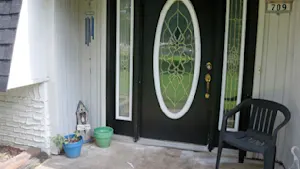More Stories
It's time to talk about back-to-school sleeping tips!
News 12's Elizabeth Hashagen and Elisa DiStefano got some tips from Allison Ambort-Gubelli, of Sleepwise Consulting.
Here are some tips from Ambort-Gubelli:
1. Set an age appropriate bedtime
Up until puberty, (12/13 years old), children need between 10-12 hours of sleep each night.
Once in the teenage years, sleep needs can reduce a bit, but the reality is, these kids still need between 9-10 hours of sleep at night.
Based on these sleep needs, we need to make sure we’re giving or children (and ourselves really) the opportunity to get the hours of sleep we need each night.
When we think about what time most students need to be up in the morning to get everything done to get them off to school, we’re looking between 6-7 o’clock AM.
With this in mind and considering the sleep needs of most school aged children, ideally, we want to be shooting for lights out by 8 pm maybe 8:30 depending on how quickly and cooperatively your children go to bed that way even if it’s taking them some time to settle in, they’ll still have an opportunity to be asleep by 9pm.
Now I’m sure some parents of older children may be watching and thinking, well this is great but it’s not going to work for us, my kiddo’s going to sleep at 10/11pm every night, there’s no way I’m getting them in bed, lights out by 8, even 830.
And there’s some truth to that sentiment. Our internal circadian biological clocks require consistency and repetition to establish our natural sleep pattern. In cases where kids have been going to bed later, in the 10/11pm range, what you’ll want to do is gradually step in to an earlier bedtime. Move bedtime 15 minutes earlier every 3-4 days until you reach your ideal bedtime.
This will help your kiddos ease into an earlier bedtime if they’re stuck in a pattern of going to bed late and sleeping in in the morning.
Be patient, it’s a process and it can take time to come together.
2. Establish a consistent and concise bedtime routine
Bedtime routines are absolutely crucial in fostering healthy sleep habits because it acts as a cueing system to get our brain and our body ready to transition and prepare for nighttime sleep.
It’s telling your brain, okay I’m going to do these 4-5 activities in the same over every night and then I’m going to go to sleep. This lets our bodies know that sleep is coming and night is approaching.
Therefore, we want to see a concise and predictable routine.
An example of a solid bedtime routine would be
Bath/shower, PJs, brush teeth, reading with a parent or on their own (10-15 minutes), lights out.
You want to aim for your bedtime routine to take roughly 30 minutes in length, maybe a little bit longer for older kids; however, anything longer than that leaves an opportunity for overtiredness or overstimulation depending on what their reading and how cooperative they are with settling in.
If you have a little one who’s testing limits and pushing the boundaries to see how serious you are about getting them back on track with sleep, two things to try are:
1. Use a timer (Stalling)
o “You have 20 minutes to get yourselves showered, in your pajamas, teeth brushed, to be ready for reading time, if you can’t do it in 20 minutes then you don’t get any reading time and its lights out”
o Only takes a couple of times
2. Offer reward incentive
o Rewards do not need to last forever
o Short shelf life, sizzles out
o If you find its late October and you’re still being hounded for a reward, Transfer the reward to another area that they’re struggling with, reframe it, you’ve been doing great with this but I’ve noticed … (your room isn’t kept tidy, you’re leaving your clothes on the floor, etc.).
3. No screens at least 1 hour before bed.
No TVs, phone, video games, tablets, laptops, computers, etc. This is very important.
The number one reason that children, adolescents and even adults are having sleep issues is screens.
The reason is, when we’re looking at screens, we’re blasting light into our eyes. This exposure to light sends signals to the brain to delay the release of hormones like melatonin which is associated with sleep onset and is produced when the eyes signal to the brain that it is dark.
Melatonin levels rise in the evening and stay elevated throughout the night to promote sleep. It is extremely important for sleep onset (falling asleep in a timely manner) and staying asleep through the night.
In teenagers, research has shown that melatonin levels in the blood naturally rise later at night than in most children and adults. Since teens may have difficulty going to bed early to get enough sleep, it can help to keep the lights dim at night as bedtime approaches. It can also help to get into bright light as soon as possible in the morning to help shift their circadian rhythm to meet the expectations of early school start times.
You cannot just pop a melatonin pill before bed and expect to sleep through the night, it may help with falling asleep quicker; however, it will not help you stay asleep. You need an appropriate sleep environment and solid independent sleep skills for this piece of the puzzle.
Need to let melatonin build.
4. Setting up an ideal sleep environment
Lighting: Dark.
Since the receptors in our eyes send signals to our brain to inhibit or release certain hormones based on exposure to light, one thing to help ease the transition to an earlier bedtime in the presence of a late sunset and early sunrise is a dark bedroom.
You’re going to have to work to get that room dark.
We really need to have a dark room in order to get melatonin to rise to an appropriate level so that your children can fall asleep quickly and stay asleep throughout the night.
Get some high quality black out blinds, tape them to the wall so that there’s no light coming in around the cracks and make sure that room is as dark as you can possibly make it.
Temperature: Cool, between 68-72 degrees.
Limit extraneous sensory stimuli: White noise can be helpful but is not necessary.
More from News 12
2:34

Guide: Safety tips to help prevent home burglaries
2:19

Guide: Safety measures to help prevent fires and how to escape one
2:07

Tips on how to avoid confrontation with sharks while swimming in the ocean
2:33

5 tips to prevent mosquito bites and getting sick from viruses
2:39

NEWS 12 EXCLUSIVE: ‘He drove into the water.’ Car drives off dock in Patchogue; News 12 crew helps in the rescue
0:44
